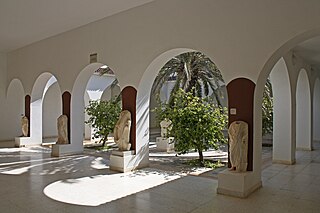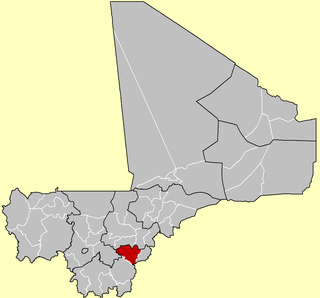
The Tunisian Sahel or more precisely the Central East Tunisia is an area of central eastern Tunisia and one of the six Tunisian regions. It stretches along the eastern shore, from Hammamet in the north to Mahdia in the south, including the governorates of Monastir, Mahdia, Sfax and Sousse. Its name derives from the Arabic word sāḥil (ساحل), meaning "shore" or "coast". The region's economy is based especially on tourism and it contains the second-biggest airport in Tunisia: Monastir Habib Bourguiba International Airport.

Sousse or Soussa is a city in Tunisia, capital of the Sousse Governorate. Located 140 km (87 mi) south of the capital Tunis, the city has 271,428 inhabitants (2014). Sousse is in the central-east of the country, on the Gulf of Hammamet, which is a part of the Mediterranean Sea. Its economy is based on transport equipment, processed food, olive oil, textiles, and tourism. It is home to the Université de Sousse.

David John Mattingly, FBA is an archaeologist and historian of the Roman world. He is currently Professor of Roman Archaeology at the University of Leicester.

El Djem Archaeological Museum is an archaeological museum located in El Djem, Tunisia. It contains Roman era art, including mythological personages, abstract elements and fauna.

The Lamta Archaeological Museum is an archaeological museum located in Lamta, Tunisia.
The Sfax Archaeological Museum is an archaeological museum located in Sfax, Tunisia.

The Sousse Archaeological Museum is an archaeological museum located in Sousse, Sousse Governorate, Tunisia.

Koutiala Cercle is an administrative subdivision of the Sikasso Region of southern Mali. The administrative center is the town of Koutiala. The Cercle is divided into 36 communes.

Kasserine is the capital city of the Kasserine Governorate, in west-central Tunisia. It is situated below Jebel ech Chambi, Tunisia's highest mountain. Its population is 114,463 (2020).
Dahmani, formerly Abbah Quşūr, is a town and commune in the Kef Governorate, Tunisia. As of 2004 it had a population of 14,061. It is located at 625 meters above sea level, 225 kilometers southwest of Tunis.
Menzel Ennour is a town and commune in the Monastir Governorate, Tunisia.
Jebiniana is a town and commune in the Sfax Governorate, Tunisia.
Messaadine or Messaâdine is a town and commune in the Sousse Governorate, Tunisia, located four kilometres northeast of M'saken and seven kilometres southwest of Sousse, along Route RN1, a highway connecting Sousse and M'saken. Administratively part of M'saken, it had a population of 12,916 inhabitants in 2014.
Sidi El Hani is a town and commune in the Sousse Governorate, Tunisia located at 35.67n, 10.30e. As of 2004 it had a population of 3,058. It gives its name to the largest lake of the governorate, a natural salt lake or salt pan (sabkha) in dry seasons, the Sebkhet de Sidi El Hani which is shared with between one and two other areas depending on precipitation and its maximum extent forms the official boundary with part of a third, Monastir Governorate. The town is 30 km south-west of the coast, its straightest connection being by Tunisian Railways, with a secondary connection by road, the P12 road which is a principal road to Kairouan from the A1 a few kilometres to the east. it is 19 km from Kairouan and 26 km from Raqqada.
Hazel Dodge is senior Lecturer of Roman Archaeology at Trinity College, Dublin. She holds her degrees from the University of Newcastle-Upon-Tyne and her research interests include the Eastern Roman Empire, the Roman construction industry and the city of Rome. Her PhD concerns the use and distribution of marble from the Eastern Empire. She has published extensively on Roman archaeology often in collaboration with colleagues such as Peter Connolly and Jon Coulston to whom she is married. One of her most notable publications is "the Archaeology of the City of Rome" and most recently she has published a volume on spectacle in the Roman World for Bristol Classical Press. A new source book on Rome with Jon Coulston and Christopher Smith is forthcoming. In 2010/11 she was a guest lecturer with the Archaeological Institute of America.

Sayada is a city in the Sahel region of Tunisia. It is located about fifteen kilometers south of Monastir. It is part of the administrative governorate of Monastir, and is the county seat of the Sayada-Lamta-Bou Hajar Delegation which has a population of 22,944.

Pupput, also spelled "Putput", "Pudput", "Pulpud" and "Pulpite" in Latin, sometimes located in Souk el-Obiod ou Souk el-Abiod, is a Colonia in the Roman province of Africa which has been equated with an archaeological site in modern Tunisia. It is situated on the coast near the town of Hammamet, between the two wadis of Temad to the north and Moussa to the south. Much of the Pupput is buried under modern holiday developments which have been built over the major part of the site.

The Kelsey Museum of Archaeology is a museum of archaeology located on the University of Michigan central campus in Ann Arbor, Michigan, in the United States. The museum is a unit of the University of Michigan's College of Literature, Science, and the Arts. It has a collection of more than 100,000 ancient and medieval artifacts from the civilizations of the Mediterranean and the Near East. In addition to displaying its permanent and special exhibitions, the museum sponsors research and fieldwork and conducts educational programs for the public and for schoolchildren. The museum also houses the University of Michigan Interdepartmental Program in Classical Art and Archaeology.

Meninx is a Tunisian archaeological site located on the southeastern coast of the island of Djerba, near the present city of Henchir El Kantara. It stretches 2 kilometers (1.2 mi) long and 800 meters (2,600 ft) wide, some of which has probably been submerged by the sea. The theater is at 33.688° N, 10.925° E.
Lea Margaret Stirling is a Canadian classical scholar and professor in the Department of Classics at the University of Manitoba. Her research focuses on Roman archaeology and Roman art with particular emphases on Roman sculpture, Late Antique art, and cemetery archaeology, and Roman North Africa.













